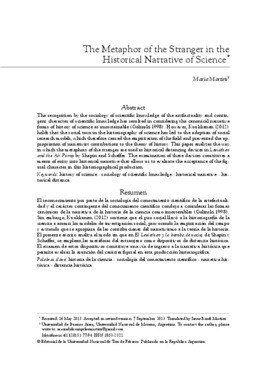The metaphor of the stranger in the historical narrative of science
Resumen
The recognition by the sociology of scientific knowledge of the artifactuality and contingent character of scientific knowledge has resulted in considering the canonical narrative forms of history of science as unsustainable (Golinski 1998). However, Kuukkanen (2012) holds that the social turn in the historiography of science has led to the adoption of social research models, which therefore caused the empirization of the field and prevented the appropriation of narrativist contributions to the theory of history. This paper analyzes the way in which the metaphors of the stranger are used as historical distancing devices in Leviathan and the Air-Pump by Shapin and Schaffer. The examination of these devices constitutes a means of entry into historical narrative that allows us to evaluate the acceptance of the figural character in this historiographical production. El reconocimiento por parte de la sociología del conocimiento científico de la artefactualidad y el carácter contingente del conocimiento científico condujo a considerar las formas canónicas de la narrativa de la historia de la ciencia como insostenibles (Golinski 1998). Sin embargo, Kuukkanen (2012) sostiene que el giro social llevó a la historiografía de la ciencia a asumir los modelos de investigación social, provocando la empirización del campo y evitando que se apropiara de las contribuciones del narrativismo a la teoría de la historia. El presente escrito analiza el modo en que en El Leviathan y la bomba de vacío, de Shapin y Schaffer, se emplean las metáforas del extranjero como dispositivos de distancia histórica. El examen de estos dispositivos constituye una vía de ingreso a la narrativa histórica que permite evaluar la asunción del carácter figural en esta producción historiográfica.

